Crowned eagle (Stephanoaetus coronatus)
Found only in Africa, in a relatively small area. A distinctive feathering and profile make the crowned eagle one of the most eminent birds of prey in the world. The name ‘crowned’ eagle (or alternatively African crowned eagle) refers to its specific crown. The crowned eagle is also at the top of our list of the most powerful birds of prey and one of the biggest eagles.
Classification
- Class: Aves
- Order: Accipitriformes
- Family: Accipitridae
- Genus: Stephanoaetus
- Species: Stephanoaetus coronatus
- Names: Crowned eagle, African crowned eagle, crowned hawk-eagle

Areas of occurrence
It inhabits the African continent exclusively, its range includes:
- Central Ethiopia
- Uganda
- Forests of Tanzania and Kenya
- RSA all the way to Knysna
- African jungle
- Senegal
- Gambia
- Sierra Leone
- Cameroon
- Forest of Guinea
- DRC
- Angola
Despite the large population, the crowned eagle is presently a rarity in many regions of West Africa.
It mainly inhabits thick forests, including the heart of the African jungle, but also forested slopes, acacia forests on river embankments and hills. It is observed up to the altitude of 3000 meters above sea level, sometimes chooses savannas and eucalyptus plantations for its habitat (especially the southern populations).
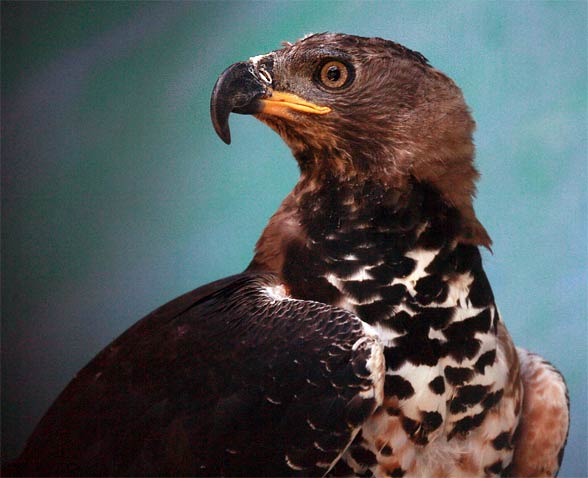
Appearance
It is one of the largest eagle species, which body length ranges from 80 – 99 cm (31 – 39 in)); females usually weigh 3.2 – 4.7 kg, while males: 2.55 – 4.12 kg (5.5 – 9 lb). Its wingspan is from 1.51 – 1.81 m (4 ft 11 in to 5 ft 11 in). The tail is usually 30 to 41 cm long (12 – 16 in), and the mean length of its beak is about 5 cm (2 in).
Its legs and feet are thick and massive, the length of its tarsus reaches 8.5-10.3 cm, talons are also thick and sizeable, proportionally to the legs. Although thorough measurements were never conducted, an eagle was found, which claw at its first toe was 6.2 cm (2.4 in) long, so almost as long as a golden eagle`s (Aquila chrysaetos) or a harpy eagle`s (Harpia harpyja).

Crown
An adult eagle is covered with characteristic patterns, its crown has a russet-brown coloration, while the edges of feathers may be white. The middle cephalic feather is slightly longer than others, which gives the head a triangular look.
Feathering
Its back and top of the wings are brown-grey, often with a blue touch. The jowl is brown, breast and belly are black and white, a dense feathering ornamented with numerous speckles. Its retrices` bases are white, embellished with single dark and bright stripes, the edges being white. Thighs and legs are motley, covered with black and white speckles, the bottoms of wings being dark, chestnut-colored, or even sometimes black.
Its eyes are normally yellow or almost white, the beak and talons are black, feet being of bright yellow color. Adolescent eagles usually have white feathers on their heads, which contrast with the black thighs. Their backs are bright brown or grey-brown with bright feather edges, their beak being grey and legs – dull yellow; after 4 months the thigh feathers transform from the immature fluff to the ‘adult’ form.
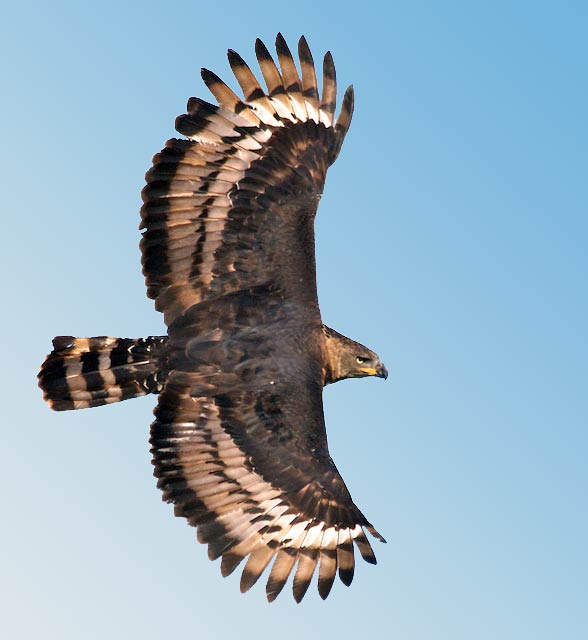
Diet and hunting style
The crowned eagle is considered Africa`s strongest predator, even dominating over two heavier eagles: the martial eagle (Polemaetus bellicosus) and Verreaux’s eagle (Aquila verreauxii).
In forest areas, their hunting territory is as large as 6.5 to 16 km2 (2.5 to 6.2 mi2) being smaller in other habitats (e.g. rocky hills and cliffs abundant with hyraxes).
The eagle starts searching for food at dawn and after sunset. As a forest animal, it does not have to fly far in seek of the prey, it is mostly a sedentary species. It is a passive hunter, finding its victims through surrounding sounds (e.g. directed by the noisy vervet monkeys (Chlorocebus pygerythrus) or regular patrol flights.
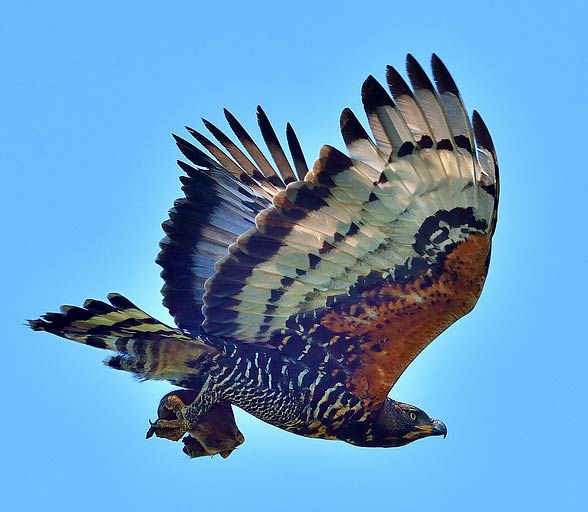
Hunting between the trees
When an eagle spots prey mid-flight, it maneuvers with great speed and dexterity between the trees in order to catch the victim unawares. Strong talons may act like a bashing weapon – the prey`s death is often a result of an extraordinarily powerful blow, among other causes of death like deep wounds or suffocation.
The crowned eagle besides killing an animal on the ground also has the ability of a vertical flight, which allows him to fly above the tree canopies with the hunted food unless the victim is too large, in which case it divides it into portions.
Crowned eagle is an excellent hunter on the ground, as opposed to the harpy eagle which strikes from the air.
It mostly feeds on small mammals weighing from 1 kg to 5 kg (2.2 – 11 lb). One of the most often caught preys are the hyraxes, also being a tasty meal for the martial eagle and Verreaux’s eagle.
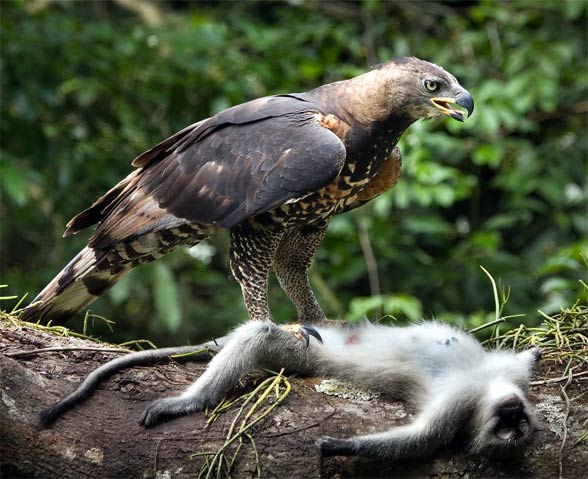
Prey size
Based on the analysis of found bone remains it has been estimated that over 51% of remains found in Garden Route belonged to animals weighing less than 2 kg, about 26% were bones of animals which weight ranged from 2-20 kg (4.4 – 44 lb), 22.5% belonging to creatures heavier than 20 kg (44 lb). Around 91% of 87 found bones belonged to sizeable antelope species. Eagles from the Ivory Coast prefer they prey around 5 kg (11 lb) of weight.
Monkeys and antelopes – a favorite meal
Forest populations often hunt for monkeys, maintaining a more diversified diet beyond tropical rainforests, eating more antelopes (e.g. Kirk`s dik-dik (Madoqua kirkii) or grey rhebock (Pelea capreolus)) and hyraxes.
Usually, young animals and mature females are the easiest catch. The National Geographic film crew has recorded material, in which the crowned eagle also hunts for water chevrotain (Hyemoschus aquaticus).
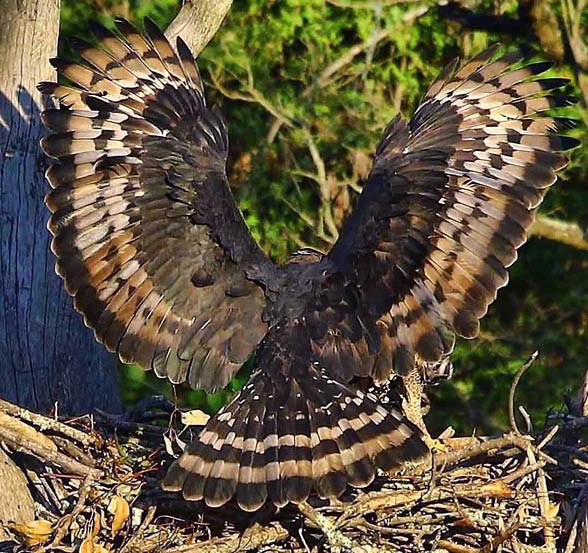
Lifestyle, character
Like most African birds of prey, the crowned eagle does not migrate, spending most of its life on the trees. This species normally occupies a single territory for its whole life. However, there is evidence of moving the boundaries of individual territories when the situation demands it.
Adolescent eagles are most active, when seeking their own territory.
Sounds
It is a loud bird, which uses its vocalizations in multiple situations e.g. in Equatorial Africa it squeals during flight, while in other regions it can emit sounds during mating or in the nesting season. It makes sounds resembling a whistle: males vocalize through combinations of rising and falling tones over the tree branches both in the hatching season and beyond it – it is a mark of its territory. It is believed that females vocalize more seldom and have a more mellow tone.
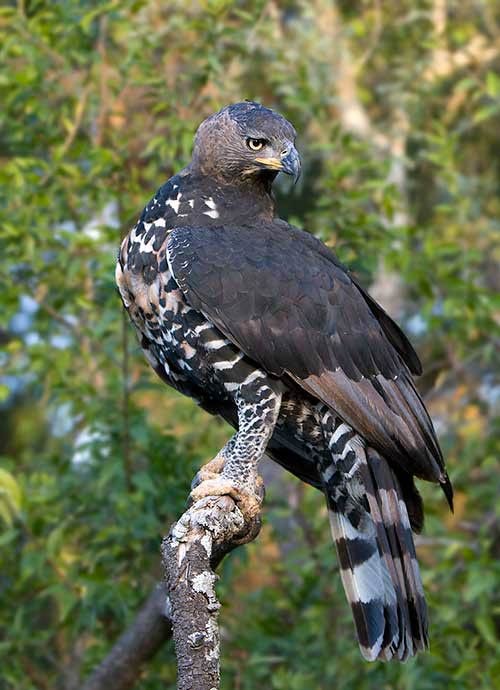
Flight
Eagle pairs also make conjoined sounds during flights, especially when partners meet up after a period of separation. These birds often perform astonishing flight sequences, including e.g. freefalling just before flying up to several hundred or even several thousand meters.
Despite its skills, crowned eagle is often described as clumsy when compared to open air species.
It is a rather nervous species, constantly vigilant and restless, yet – oh, the irony – its hunting tactics require much patience and involves lengthy periods of waiting for prey. Older eagles are really bold when confronted with humans and often, if hesitant at the beginning, finally react aggressively.
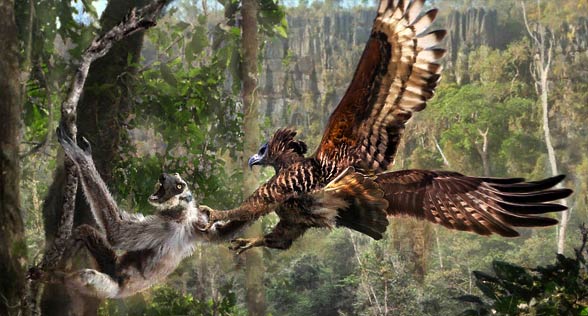
Habitats and intelligence
This bird may make its nests in many kinds of habitats, even in suburban areas, as long as there is plenty of food and flora necessary to build and improve their nests, also being necessary for hunting.
Crowned eagle is deemed by some researchers to be a highly intelligent, wary and independent animal, being more inquisitive than its relatives of the Accipitridae family.

Falconry
In the case of using crowned eagles in falconry, the technique of increasing the bird`s appetite (in order to trigger its hunting instinct towards large animals, as it is commonly used among other birds of the same family) proves ineffective.
Adult eagles do not like to cooperate with people as a general rule, usually avoiding contact, however, adolescent birds may be raised to be rather timid. Moreover, crowned eagle populations show the largest disparity in terms of temper when compared to the bird`s relatives.
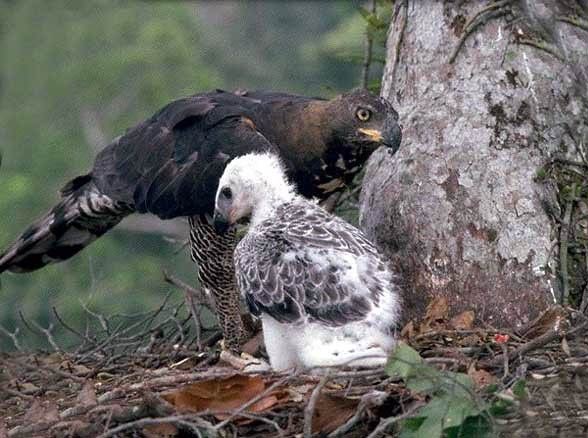
Breeding
It is a monogamist, choosing its partner for a lifetime. The mating ritual involves males` aerial performances accompanied by loud vocalization. Then the pair begins to build a nest, usually very high: from 12 up to 45 meters above the ground.
Nest
The hatching nest will be used by the same eagle couple throughout the next years, becoming gradually larger, even several times the original size. The newly built nest is relatively small, but accumulating extra branches and perfecting the whole construction results in a stunning final effect, for the long-term couples` nests may reach over 2 meters (6ft 7 in) in diameter and about 3 m of depth (9ft 10in).
The crowned eagle has one of the longest fertile periods, as it lasts for a total of about 500 days, breeding once every two years.
Females lay 1-2 eggs, which are incubated for about 49 days, when the male eagles bring food to the home nest.
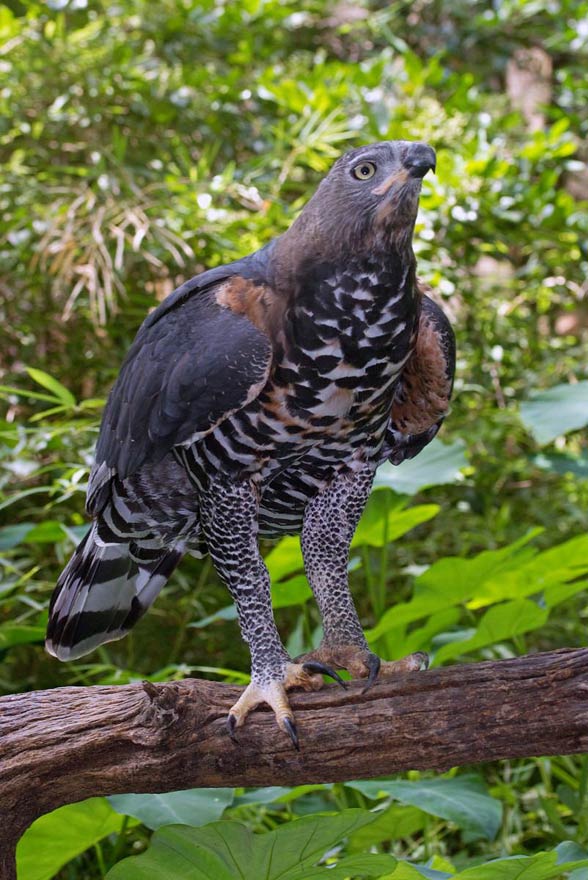
Offspring
Incubation is in 90% a maternal responsibility, the father takes the duties over only occasionally. 2 eggs appear in one clutch and one of the nestlings – the younger and smaller – dies of hunger or is killed by the older sibling (which is typical for most raptors).
The surviving chick will be still fed from the mother`s beak for the next 40 days, later it will be able to acquire food itself. The chick grows feathers after about 110 days, soon after its first flight. It remains under parental supervision throughout the next 11 months, until it is fully feathered.
Such a long period of dependency is extremely rare among birds of prey, yet it allows the young eagle to be better prepared for adult life. After about 5 years the bird reaches sexual maturity and is able to reproduce.

Detailed characteristics / size
Crowned eagle (Stephanoaetus coronatus)
- Length: males: about 80 cm (31 in); females: up to 99 cm (39 in)
- Wingspan: 151 – 181 cm (4 ft 11 in to 5 ft 11 in), max. 190 cm (6 ft 3 in), unconfirmed reaching 200 cm (6 ft 7 in))
- Wing chord: 44.5–53.2 cm (17.5–20.9 in)
- Tail length: 30 – 41 cm (12 – 16 in)
- Beak length: about 5 cm (2 in)
- Tarsus length: 8.5–10.3 cm (3.3–4.1 in)
- Talons: 6.2 – 10 cm (2.4 – 3.9 in)
- Body mass:
- males: 2.5 – 4.1 kg (5.5 – 9 lb), 3.64 kg (8 lb) on average)
- females: 3.2 – 4.7 kg (7 – 10.4 lb)
- Dive speed: to 160 km/h (100 mph)
Sexual dimorphism is apparent among crowned eagles – females are 10-15% larger and heavier than males.

Crowned eagle – interesting facts
- Apart from the African crowned eagle, there was one more species in the same genus – Malagasy crowned eagle, or, Madagascan crowned hawk-eagle (Stephanoaetus mahey), but it was eradicated by the people arriving at Madagascar.
- The crowned eagle is the 5th largest and 9th heaviest present-day eagle.
- Females are usually larger than males by 10-15 %
- The crowned eagle is often considered one of the 10 strongest land animals (compared to other phyla and weight ranges).
- The crowned eagle is believed to be the strongest bird of prey in relation to its own body mass.
- Crowned eagle hunts for large prey more often than other raptors. Its menu includes e.g. mandrills, which may weigh over 30 kg (66 lb)!
- It has been observed that one of the crowned eagles` sounds lures the monkeys, which allows the bird to attract them into its close proximity to attack them subsequently.
- Crowned eagle can lift prey weighing more than itself, although it is rather a rarity.

Recommended
- Animals records
- Largest eagles Top10
- Largest birds of prey
- Steller’s sea eagle
- Philippine eagle
- Fastest animals – Top 10
- Fastest birds – Top 10
- Most venomous snakes – Top 10
- Largest sharks Top 10
- Heaviest land animals
- Largest crocodiles Top 10
- Largest whales TOP 10
- Longest snakes Top 10
- Highest (Top) flying bird – Top 10
- Largest and heaviest birds
- Largest turtles TOP 10







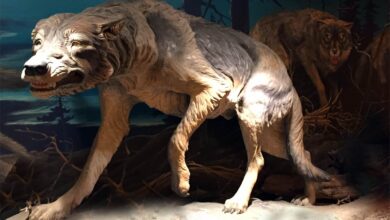

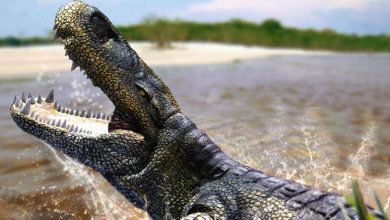





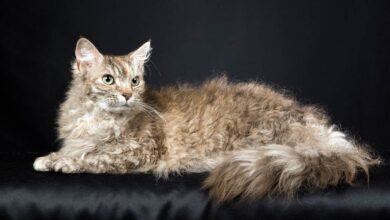



Eagles are opportunistic hunters/feeders they will take what ever is available and vulnerable prey regardless of the size especially when they have young to feed they can’t be choosy on taking food in the wild, there is no such thing as preferred larger prey and Eagles are limited only to the prey availability of their home-range especially those non-migratory and highly territorial like the harpy and Philippine eagles there are NO large mammalian prey in Philippine forests. Harpy eagle evolved hunting in the forest canopy mostly on tree dwelling animals like sloth it’s primary prey and small monkeys, birds anteaters etc. The most powerful eagle is the one that can lift heavy prey carry up to its nest It reflects the overall strength of the bird, Deer are easy picking for eagles any large eagle specie can tackle a deer regardless how big or heavy, they can’t fight back to an aerial predator with a razor sharp claws and tremendous powerful grip. Martial eagle known to feed primarily on birds but has the record of having predate on the largest live prey a 37 kg (82 lbs) Duikers.